Siding is a versatile building material that is used on walls, for finishing windows and doors on the facade. Openings are either sloped or flush with the wall. Framing windows with siding can be done with your own hands, while you need to study the technology of work and follow the instructions exactly. The process of installing profiles is different from cladding straight sections.
Siding Information
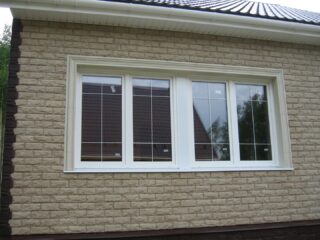
Siding is not only a certain type of profile, the concept is used to denote finishing technology for protecting walls and decorating buildings.
By the type of fastening of the strips, the type of installation is distinguished:
- vertical;
- horizontal.
In Russia, panels are placed horizontally for private houses, and the first type is used in the decoration of industrial, non-residential buildings. Horizontal siding made of wood is produced with imitation of a ship board, logs, in the performance of a "herringbone".
Plastic and steel varieties are made with a pattern of wood, natural stone. Houses with walls and slopes made of this material allow you to create the image of a modern European house. Wall panels and a window profile for siding are mounted using a lathing, self-tapping screws are used for fastening. The frame system allows you to insulate the junction of the window to the end of the wall, to make waterproofing.
Benefits of siding framed slopes
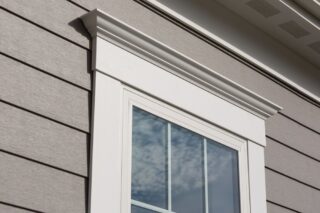
Vinyl or metal siding strips are overlapped, while providing a natural flow of air to the surface of the facade.
The materials are different, but the general advantages of siding can be highlighted:
- reliably protects against precipitation;
- surfaces are easy to wash and clean;
- installation takes place quickly, subject to technology;
- siding slopes are beautiful, increase the attractiveness of the house;
- durable finish serves 30 - 50 years without loss of quality;
- the material does not need pretreatment with protective agents.
The stripes do not make the facade heavier, so there is no need to install a reinforced base under the house. Window decoration is not subject to corrosion. The material has a wide variety of colors and patterns on the surface. Siding is resistant to temperature extremes and has an affordable cost.
Types of siding for finishing
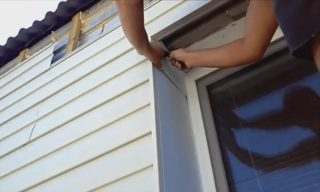
In addition to PVC and metal plates, wood and cement siding is used. The latter type has significant weight, it is rarely used for home decoration, especially for siding slopes.
The vinyl variety is most commonly used. The material is produced by forcing molten raw plastic mass through extrusion machines to obtain strips of the required profile and size.
Modern production uses the co-extrusion method, when the panel is made by joining two layers at the molecular level:
- the top layer (capslok) protects the product from ultraviolet radiation, moisture, it makes up a quarter of the total thickness;
- the inner layer (substrate) is responsible for strength, resistance to frost and heat, retains the original shape of the strip.
Modifiers for color fastness, quality stabilizers, pigments are introduced into the composition of raw materials.
Metal siding for window slopes is considered the most durable of materials, therefore it is used for exterior decoration of expensive and decorative buildings.It is based on galvanized metal, profile varieties differ in the initial thickness of the workpiece. The quality of sandwich panels also differs from the type of coating on the surface of the steel base.
The structure of the metal siding panel is represented by a heterogeneous solid material, consisting of layers:
- at the top of the steel sheet, a layer of zinc, anti-corrosion film, primer and decorative coating based on polymers;
- at the bottom there is a galvanized coating, anti-corrosion protection, a protective paint film.
The quality of metal siding depends on the number of protective layers and their thickness.
The decoration of windows and doors with siding is matched to the color of the walls. If the facade is made with metal sandwiches for wood, the slopes must be sheathed in the same way.
Materials and tools for work
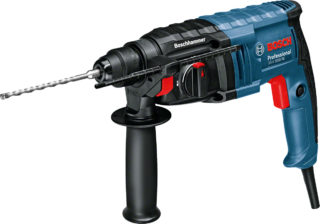
Installation of siding on slopes is performed using accessories and profiles. Windows can be bypassed with finishing using galvanized elements or using wooden battens. The second option requires a lot of effort and slows down the work. The tree absorbs moisture, therefore it requires preliminary impregnation with antiseptics, fire retardants, anti-decay agents.
Galvanized profiles are more suitable, they are always even, they do not need processing:
- J-profile window strips are used. The number of elements is calculated so that they become around the entire perimeter of the frame.
- Self-tapping screws are prepared for fastening if the walls are made of wood. For stone, blocks, concrete, brick, take plastic dowels with a self-tapping screw.
- To install deep siding slopes, double-sided corner profiles are required.
- Depending on the installation conditions, ebb and window covers may be required.
The markings before installation and for cutting the profile are made with a tape measure, a marker, right angles are marked with a carpenter's square. The horizontal and vertical are checked using a plumb line, level.
The following instruments are prepared:
- screwdriver, drill;
- a hacksaw for metal or scissors for iron, a hammer, a construction knife;
- for marking - cord, screws.
A perforator is needed to install strips on walls made of brick, concrete. Punch - a special tool for cuts from one side of the panels, easy bending of the cut part on the siding element.
Wall preparation and lathing
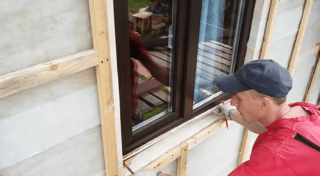
They remove the old trim elements, if they are on the facade: platbands, ebbs, visors, awnings. Outside, old plaster is knocked down from the slopes in order to leave only the end of the facade walls. Cracks are embroidered (deepened and repaired with repair mortar). In wooden houses, cracks are covered with a special compound for woodworking. If the dowel gets into the gap, the crate will be weak, loosen over time.
Rules for the manufacture of lathing for edging windows on the facade with siding:
- the lattice is made so as to exclude contact of the siding with the facade, while providing ventilation;
- the frame serves as a support for additional strips, therefore the elements are installed strictly vertically and horizontally;
- galvanized profiles are connected to each other with self-tapping screws in the "flea" type.
Insulation is placed in the body of the crate, a layer of waterproofing is placed. Provide support for ebb tides, cornice element.
Siding decoration
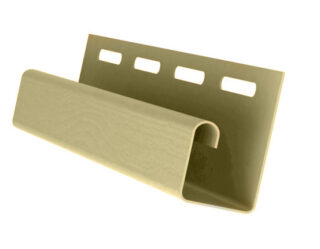
The principle of cutting and installing the J-profile is the same for all cases - you should get a neat cut and a beautiful joint. The tongue of the horizontal strip at the top forms a kind of drain for water, and the cuts near the window strip are made with scissors for the iron. For fastening a part with a cutout, new holes are formed using a punch.
Finishing options:
- The frame is flush with the wall. Measure the distance around the perimeter to fix the J-planks. Cutouts are made on the siding panels for joining, leaving a thermal gap for expansion. Before attaching the siding siding sheet, a supporting profile is placed for strength. The upper trim is similar to the lower one.
- Overlap.J-slats are cut to the size of the window in width, height. The upper profile is cut, folded down, taking into account the width of the element. The side trims are inserted into the upper profile so that the bent flyout enters it. A gap of 3 - 5 mm is left between the parts for expansion. The lower part is also placed with a gap of 3 mm to the side elements.
- To the corner. The installation method resembles the previous one, but the upper part and the side parts of the slopes are cut at an angle of 45 °, so that it is convenient to combine horizontal and vertical elements. Leave a thermal gap for expansion according to the dimensions indicated above. All cuts of metal siding are treated with paint before installation to restore the integrity of the protective layer.
If the window openings are sloped, a double-sided corner element is placed on the outer part of the wall end, into which the edge of the siding panel is placed. When setting the angle, the hardware is screwed along the center line of the oval holes in order to prevent subsequent deformation. A J-profile is then mounted around the perimeter. It is advisable to place the siding horizontally on the slopes so that the cut ends of the parts clearly fit into the grooves.
Features of finishing arched windows
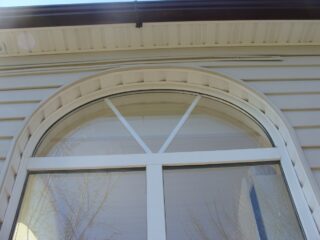
The cladding is performed using a flexible J-strip, which is mounted along the perimeter of the arch. The hardware is placed with a step of 150 mm. When installed in the J-profile, the ends of the siding are cut so that they fit snugly and without gaps - this concerns the joint in the lower corners of the opening.
Use self-tapping screws with a galvanized coating or stainless steel. They are screwed in at an angle of 90 ° so as not to reduce the strength of the fastening. For work, a screwdriver with a limiter is used so as not to immerse the hardware more than the required depth.
If there is no flexible profile, cuts are made in the usual one to bend the panel to the desired radius. It is best to do this from the inner side of the strip. Metal panels are difficult to bend, and vinyl panels are flexible for mounting on arched openings.








